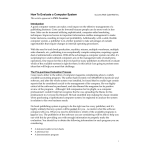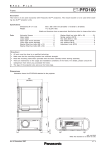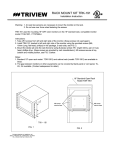Download LAP-SE-130-CS- Customer Service in Selling
Transcript
LAP Leadership, Attitude, Performance ...making learning pay! Selling LAP 130 Performance Indicator: SE:076 Go Beyond the Sale Customer Service in Selling Crush the competition Go Beyond the Sale More than a department Ingram Publishing/Thinkstock Can you spot an opportunity? LAP-SE-130-CS © 2014 MBA Research and Curriculum Center® 1 A Beyond the Sale Y Trey is a technology coordinator for a local school district. He recently needed to purchase several new monitors and printers for one of the school libraries. He found a great price on monitors from ABC Company and a great price on printers from XYZ Company. Neither shipment arrived on the expected date. When Trey called ABC Company, he was referred to voicemail. When he called XYZ Company, he was transferred to the shipping and delivery department right away. He spoke to a representative who tracked the shipment and let him know that it was late due to bad weather and would arrive the next day. He never heard back from ABC Company, although the monitors did arrive two days later. What does this situation illustrate about the importance of customer service in selling? ABC Company gave Trey the best price, but what will happen the next time he needs to order monitors? He’ll remember his bad experience and probably think twice about buying from ABC again. The company’s poor customer service cost them a repeat customer! That’s why customer service is a key component of the selling relationship. Read on to learn more about this important aspect of selling! Objectives A Explain how customer service facilitates sales relationships. B Identify opportunities to use customer service in facilitating sales relationships. 2 LAP-SE-130-CS © 2014, MBA Research and Curriculum Center® ou just finished a killer sales presentation and closed the deal. You did it—you made the sale! It’s time to kick back, relax, and pat yourself on the back, right? Well, you might not want to celebrate just yet. You still have some work to do! Making the presentation and closing the sale are just the beginning of your journey as a salesperson. Servicing the sale is one of the most important things you can do to generate and keep loyal customers for your business. Duncan Smith/Thinkstock Closing the sale is just the beginning of your journey as a salesperson. If you want to generate and keep customers, you’ll need to practice great customer service. Customer service in selling When it comes to selling, what does customer service really mean? Is it a counter at the back of a retail store that accepts returns and exchanges and provides gift wrapping? Well, maybe. In that case, customer service is more of a function than a process, more of a department than a relationship. The kind of customer service you need to demonstrate as a salesperson goes far beyond the boundaries of a mere business function. It’s an attitude, a set of skills, and a style of work that you should carry with you for your entire career. Simply put, customer service encompasses all activities and benefits provided by a business to its customers to create goodwill and customer satisfaction. Customer service should result in enhancing and facilitating the customer’s use of the good or service. For instance, if a manufacturing company purchases equipment from your business, how useful will it be if the company doesn’t know how to use it? A successful salesperson provides quality customer service to that company by making sure employees have the necessary information to use the product. This might mean going through the instructions during the sales presentation or visiting the company and conducting on-site training. Go Beyond the Sale A The competition starts here If you offer a product with the best price and the best quality, you might think you’ll beat all the competition. Unfortunately, that will only get you so far—over time, price and quality can be easily matched among competitors. In selling, customer service is where the real competition among businesses begins. For example, imagine you’re a salesperson for a company that manufactures tires to sell to automakers. The tires you make aren’t much different than the tires your clients could get from any other company, and the prices are similar, too. That’s when customer service becomes key. Are you available when your clients need you? Are you willing to help them when they need to change orders? Can you help your customers if there’s a problem with their shipments? These are the actions that will separate your company from the rest of the pack. As a salesperson, you need to show prospects that your company meets (and hopefully exceeds) these types of customer-service expectations. Shifting expectations Customer service is not one size fits all! It’s up to you to cater your customer service towards your customers, each of whom is a unique person with his/her own unique expectations. These expectations may be based on: • Past experience—If the customer has done business with you before, s/he will expect the same or higher quality of customer service. If another salesperson offered free installation on the last appliance the customer purchased, you can bet that customer will want the same deal from you. Customers will also compare your service to past service they have received from your competitors. • Word-of-mouth—If your friends, family, or colleagues raved about the customer service they received from a business, you’d probably check it out, right? That’s the power of word-of-mouth information! New customers will come to you based on the recommendations of people they trust. They will expect to receive the same quality of customer service that others have received. • Advertising—Your business probably invests in advertising to let potential customers know about your superior products and services. But be careful—customers expect you to keep your promises. For example, if your pizza place advertises that every pizza will be delivered within half an hour, you’d better hold up your end of the bargain! • Individual needs—Every client is different. Some might want an extended product warranty, while others don’t care about warranties at all. Some clients need more help than others obtaining financing or credit. Successful salespeople will learn to read individual clients and discover how to cater to their individual needs. Benefits of customer service The importance of providing quality customer service in sales cannot be overstated. Customer service benefits sales organizations by helping to build profits. Businesses exist to make money, and to do so, they rely on their customers. Providing quality customer service influences profits in two major ways: • Building partnerships with current customers. Loyalty is the name of the game—successful salespeople understand the importance of repeat business. They strive to provide high quality customer service, so they can build long-term partnerships with their customers. After all, maintaining a relationship with a current customer is less expensive and time-consuming than generating a new customer relationship. Besides repeat business, another benefit of having loyal customers is referrals. When your customers are satisfied, they will tell their family, friends, and colleagues about your good service. In a sense, these satisfied customers become another “sales force” reaching out to prospects for you. What makes this benefit even better is that this sales force can reach potential customers whom you might not be able to reach on your own! Go Beyond the Sale LAP-SE-130-CS © 2014 MBA Research and Curriculum Center® 3 A • Generating new customers. Sales increase when organizations create new business and new accounts. Quality customer service improves your company’s reputation, and a better reputation means more business. Customers are much more likely to patronize a business with a great reputation. For example, if your company needs something, who are you more likely to order from—a business that’s known for treating its customers like royalty, or one that leaves customers complaining? Summary Customer service encompasses all activities and benefits provided by a business to its customers to create goodwill and customer satisfaction. Servicing the sale is one of your most important tasks as a salesperson. The kind of customer service you need to demonstrate goes far beyond the boundaries of a mere business function. Customers’ expectations vary and depend on past experience, word-of-mouth information, advertising, and individual needs. The two main benefits of providing quality customer service are building profits through existing customers and through new customers. iStockphoto/Thinkstock 1. What does customer service in selling mean? 2. How does customer service affect competition among sales organizations? 3. Describe the factors that affect customers’ service expectations. 4. Describe the two main benefits of providing quality customer service. Lee’s company is holding a contest for its salespeople, and the winner gets an all-expenses paid cruise! Of course, Lee really wants to win. To do so, he needs to close the sale he’s currently working on. The client wants to buy only if the product can be delivered by Thursday. Lee knows it’s a bit of a stretch for the shipping department, but he promises the client on-time delivery for Thursday. Even if the shipment is late, he’ll still win the cruise, and he can smooth things over with the client later. What do you think? Are Lee’s actions justified? 4 LAP-SE-130-CS © 2014, MBA Research and Curriculum Center® Go Beyond the Sale B Customer Service in Action You understand the importance of customer service in selling and how it helps build profits through new and existing customers. But what does quality customer service really mean? How can salespeople demonstrate it to their customers? Pre-sale opportunities Although most of the time, “servicing the sale” refers to actions that take place after the deal has been closed, salespeople still have many opportunities to provide customer service before the sale. One way is through suggestion selling. You can add value to a customer’s experience by suggesting additional products or services that will enhance his/her primary purchase. For example, if you are talking to a customer about a particular guitar, you might also want to point out the strap that goes along with it. Using the strap will make the guitar easier to play and should add value to the purchase of the guitar. Just be sure you only try to sell the customer goods or services that they can truly use—customers can tell when you’re taking Pre-sale opportunities: advantage of them. Appropriate, well-timed suggestion selling can go a long way toward building solid partnerships with customers. n Suggestion selling Another way to provide customer service before the sale closes is to provide ample product information. Clients can use all the help they can get when it comes to making purchase decisions, especially for high-ticket items, such as machinery, office buildings, vehicles, or expensive electronic equipment. Successful salespeople make sure that clients have all the information they need to make sound, well-informed decisions. When clients are happy with their purchases, they won’t forget the salesperson who helped them sort through the options. n Providing ample product information n Making only promises you can keep Post-sale opportunities: n n n Order processing Shipping and delivery Installation Warranty issues Maintenance and repair Credit / Financing Technical assistance and support And last, but not least, salespeople can demonstrate quality cusn tomer service before the sale by making only promises that they can n keep. It sounds easy enough, but it’s amazing how many salespeople n disregard this simple rule in an effort to close the deal. Before you tell a business customer that s/he can receive online support for a prod n Customer training uct 24 hours a day, make sure that this is really the case. If you tell a customer that routine maintenance for the product will be performed free of charge, you must make sure this is true and also take the time to explain what “routine maintenance” means to your company. Even if you forget about the promises you make during your sales presentations, your customers definitely won’t. If you can’t keep these promises after the sales close, you will have unhappy customers and damaged client relationships. n lthough customer expectations vary from person to person, there are some basic qualities of customer service that you can be sure customers are looking for. These include reliability, empathy, accuracy, consistency, and responsiveness. Go Beyond the Sale LAP-SE-130-CS © 2014 MBA Research and Curriculum Center® 5 B Post-sale opportunities Is your job over when the sale closes? No way! The post-sale period is actually a critical time to flex your customer service muscle. This time of follow-through is often what separates successful businesses from unsuccessful businesses. You probably talked a big game about your company’s high standards for customer service during your sales presentation—now’s the time to put your money where your mouth is. Let’s take a look at several areas in which post-sale customer service is necessary: • Order processing. Your customer has just requested 30 boxes of personalized stationery. You enter the order in your computer and send it off to be processed. This task is over, right? Of course not! As a salesperson, it is your responsibility to ensure that your customer’s order is processed correctly. The best way to do this is to get to know the people who are processing the order. By establishing a relationship with this department, you can easily check on the status of orders to make sure your customers are getting exactly what they want. • Shipping and delivery. You’ve probably experienced your share of shipping and delivery problems as a customer. Just think of how frustrating it can be when you order something and it arrives early or late, gets lost in transit, arrives damaged, or accidentally gets shipped to the wrong address. As a salesperson, it’s your job to do all you can to prevent this from happening to your clients. You’ll never be able to control every variable and make sure that nothing goes wrong (after all, you’re only human!), but it’s still important to stay in contact with and be available to your clients throughout the shipping and delivery process. That way, if something does go wrong, you can take immediate action to fix it. • Installation. Installation can also be a frustrating part of the purchasing process for customers. By staying involved throughout this step, you can help your customers when they run into problems. For instance, you may have promised your customer free installation, but the delivery person may be unaware of this. A quick call from you can clear up the misunderstanding in no time. Brand X Pictures/Thinkstock Salespeople are responsible for making sure products get to the customers on time. This includes being available to clients throughout the shipping and delivery process. • Warranty issues. Warranties can be very confusing for customers. A successful salesperson takes responsibility to make sure his/her customers understand exactly what their warranties cover, instead of leaving them to figure it out on their own if something goes wrong with the product. • Maintenance and repair. Certain products need routine service and may also need specialized repairs over time. Delivery vans, for instance, need regular oil changes and will probably require engine or body work at some point. Many sales organizations offer maintenance and repair services as part of the overall sales package. This is an important aspect of post-sale customer service. Successful salespeople make sure their clients understand what maintenance and repair services are available and how to take advantage of them. 6 LAP-SE-130-CS © 2014, MBA Research and Curriculum Center® iStockphoto/Thinkstock Warranties aren’t always easy to understand. Successful salespeople know how important it is to make sure customers know exactly what their warranties cover. Go Beyond the Sale B • Credit/Financing. Problems with obtaining credit and financing are a main cause of customer-service complaints for sales organizations. Conflict can arise when a salesperson assures a client that his/her business will qualify for credit, and the credit manager does not then approve the financing. There can also be problems with billing and invoices. Perhaps you’ve made a special arrangement with your client that the finance department isn’t aware of. Successful salespeople are careful in these sticky situations. They also get to know employees in their company’s credit department, making it easier for them to “go to bat” for their clients when necessary. • Technical assistance and support. Many products are tied to the need for technical assistance and support. Computers and Internet service are great examples of this. Let’s say you work for an Internet service provider, and you’ve just sold your company’s services to a start-up business. It is likely that over time the business will run into complications or have questions about its Internet connections. These questions should be your concern as well. It’s important to make sure your customers know how to reach technical support whenever they need assistance. Wavebreak Media/Thinkstock It isn’t always easy for customers to obtain credit and financing. This can be another opportunity for successful salespeople to help their customers. •Customer training. Not all products are complete with a user’s manual alone. Some products require customer training, even classes. Customer training can be as simple as the salesperson visiting a business to show employees how to use the new copier. Or, it can be as involved as hosting a week-long conference to facilitate the use of a certain software package. Providing appropriate customer training is a mark of a successful sales organization. Many post-sale problems can be prevented when salespeople take the time to check on order status, shipping status, etc. Providing quality customer service doesn’t mean you’ll never make mistakes. It does mean, however, that you take responsibility for them and work to correct them to your customers’ satisfaction. Keys to quality customer service Jupiterimages/Polka Dot/Thinkstock Many companies make providing quality customer service a high priority. How can you go a step further to set yourself or your sales organization apart from the rest of the pack? Take a look at the following keys to customer service: Successful salespeople know that the best way to prevent post-sale problems is by simply checking in on order status, shipping status, etc. It often takes just a quick phone call to make sure everything is going as planned. Go Beyond the Sale • Solicit feedback. There’s only one way to know if your customer is satisfied—ask! It’s important to give your customers convenient, user-friendly ways to provide feedback. A six-page survey that takes hours to complete isn’t going to work. It will just annoy your customers (if they even bother to fill it out!). However, a short comment card or an online survey will probably do the trick. You should also remember that soliciting feedback isn’t something you do one time. Customer satisfaction is dynamic, so it’s important to solicit feedback on a regular basis. Sure, a customer may have been satisfied last year, but you need to know if things have changed! LAP-SE-130-CS © 2014 MBA Research and Curriculum Center® 7 B • Keep in touch. Good salespeople recognize that keeping in contact with clients is one of the best ways to maintain their partnerships. In some cases, this just takes a simple follow-up phone call. A thank-you card in the mail can also go a long way to separate you from the competition. For major clients, you might even consider a personal visit. The important thing is to let your clients know they matter to you and that you appreciate their business. • Be prompt. No salesperson can ensure that nothing will go wrong during the post-sale time period. But extraordinary salespeople can set themselves apart by treating questions and complaints as high priorities and responding quickly. Often, customers are less angry about what’s wrong with their order than they are about running into delays while trying to get it straightened out. Responding to concerns promptly can mean the difference between one-time customers and repeat business. • Have a good attitude. You can do everything a customer asks and provide quality service, but if you do it with a bad attitude, you will still have an unhappy, alienated customer. Treat your customers’ problems like your problems. Even if you’re busy, frustrated, or annoyed, help your customers willingly, as if there’s nothing in the world you would rather do. Summary Salespeople can provide customer service before the sale by suggestion selling, providing product information, and making only promises they can keep. Post-sale opportunities to provide customer service include order processing, shipping and delivery, installation, warranty issues, maintenance and repair, credit/financing, technical assistance and support, and customer training. The keys to providing quality customer service are soliciting feedback, keeping in touch, being prompt, and having a good attitude. iStockphoto/Thinkstock 1. How can salespeople provide customer service before the sale closes? 2. How can salespeople provide customer service after the sale closes? 3. Describe the keys to providing quality customer service. Hemera/Thinkstock Think about a big purchase you’d like to make. Can you see yourself enjoying a brand new car? How about a fancy mountain bike or a spring break vacation? Whatever it is, you’ll likely deal with a salesperson. What could a salesperson do to help you with your purchase? How could s/he take advantage of pre-sale opportunities? Could s/he try to use suggestion selling? And what about after the sale is made? How could s/he use post-sale customer service to make sure you become a repeat customer? 1375 King Avenue, P.O. Box 12279, Columbus, Ohio 43212-0279 Ph: (614) 486-6708 Fax: (614) 486-1819 Details: www.MBAResearch.org Copyright ©2014, by MBA Research and Curriculum Center® 8 LAP-SE-130-CS © 2014, MBA Research and Curriculum Center® Go Beyond the Sale





























